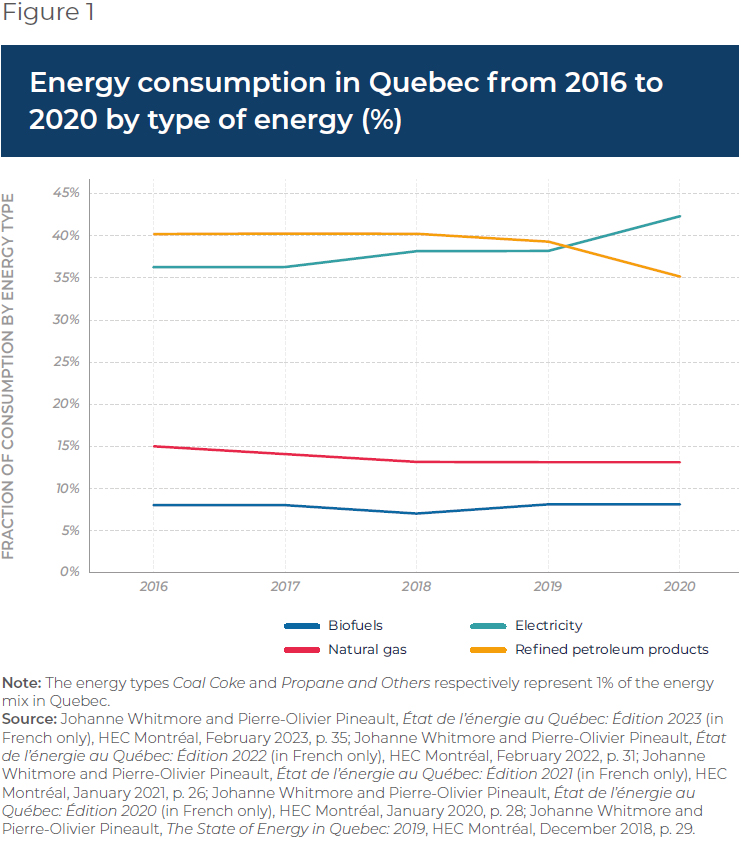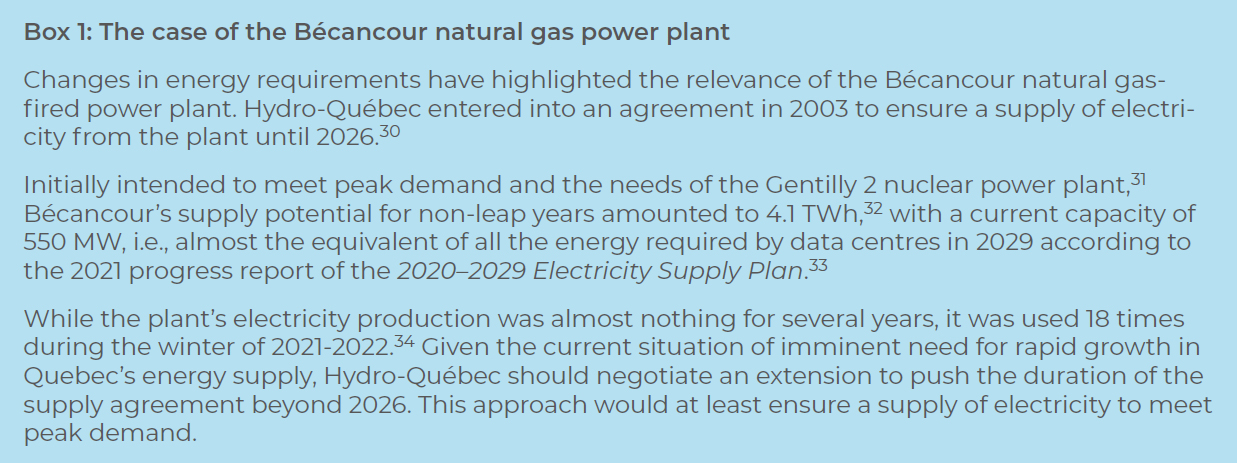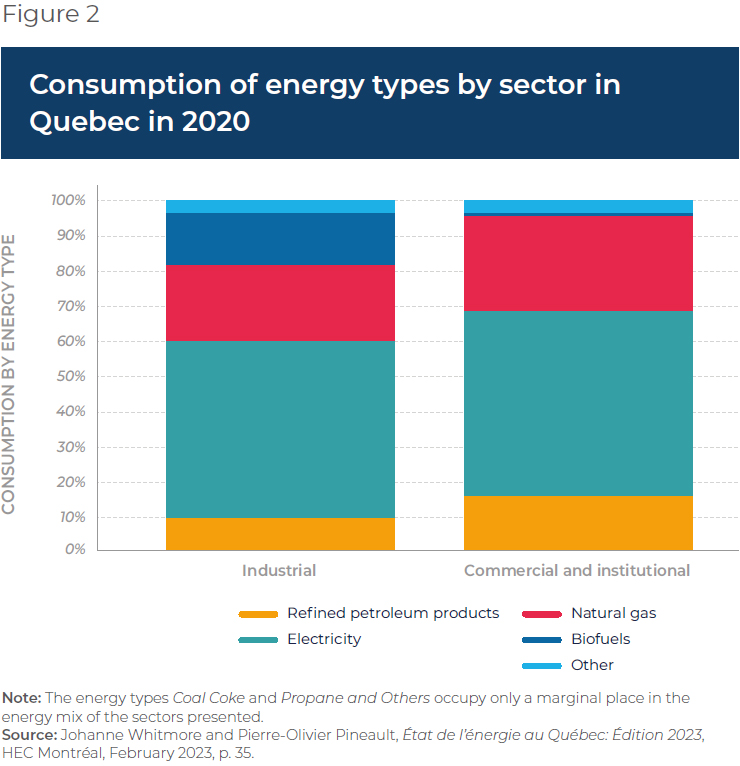Quebec’s Uncertain Energy Future

Economic Note examining options for increasing energy production in Quebec, including augmenting the role of natural gas, before the electricity surplus runs out
The end of Quebec’s electricity surplus is fast approaching, but the solutions proposed by the government are either too little or too late, concludes this study published by the MEI. “Hydro-Québec is heading towards a shortage of both energy and power as early as 2027, which complicates the problem,” says Gabriel Giguère, public policy analyst at the MEI and author of the study.
 Related Content
Related Content
 |
 |
 |
| Québec joue avec le feu en matière d’énergie, dit l’Institut économique de Montréal (Le Soleil, May 11, 2023)
Fin des surplus d’électricité en 2027: Québec n’est pas prêt à l’affronter, selon l’IEDM (Le Journal de Montréal, May 11, 2023) |
Interview (in French) with Gabriel Giguère (Mario Dumont, QUB Radio, May 11, 2023)
Interview (in French) with Gabriel Giguère (Boréale 138, ICI Radio-Canada, May 15, 2023) Interview (in French) with Gabriel Giguère (Ca$hMire, May 24, 2023) |
This Economic Note was prepared by Gabriel Giguère, Public Policy Analyst at the MEI, in collaboration with Daniel Dufort, President and CEO of the MEI. The MEI’s Energy Series aims to examine the economic impact of the development of various energy sources and to challenge the myths and unrealistic proposals related to this important field of activity.
The Quebec government, through Hydro-Québec, is working toward the electrification of many sectors of industry in the province.(1) Its Strategic Plan 2022–2026, which assesses Quebec’s electricity needs,(2) determines unequivocally that current electricity supply capacities will be insufficient to meet the growing demand from households and businesses. The next decade(3) will witness the end of surplus electricity in the province. Ensuring an increase in electricity supply in such a short period of time poses a new challenge. While wind power can play a part, complementary options must also be considered in this conversion to a heavy reliance on electricity. In order to reliably meet future demand, maintaining or even increasing natural gas, recognized as a transitional energy source, in the energy mix would appear to be necessary.
Toward the End of Electricity Surpluses
The government’s choices with respect to energy issues are geared toward reducing the use of certain types of energy historically used in the province, notably oil and natural gas, with a view to achieving carbon neutrality by 2050. These sources still represent a significant share of Quebec’s energy mix (see Figure 1). This energy transition depends heavily on electricity, and this will pose a significant challenge to the province’s future energy supply, as Hydro-Québec’s current supply will not be able to meet future demand.

However, the energy picture in Quebec is changing rapidly. In its 2023–2032 Electricity Supply Plan, Hydro-Québec forecasts significant growth in electricity demand in Quebec, estimating an increase of 14% over the next decade.(4) This rise is the result of a number of factors, including the conversion of buildings and industrial processes, the electrification of transport, and various emerging sectors (green hydrogen, data centres, battery industry).(5)
In light of this increasing demand, Hydro-Québec’s Supply Plan 2020–2029 stresses the need to increase supply rapidly: “[T]he evaluations show the need for new long-term supplies from winter 2026-2027 onwards, in terms of power, and from 2027 on, in terms of energy.”(6)
In addition to having to increase the quantity of electricity to be delivered, Hydro-Québec will also have to increase the power available.(7) The importance of energy capacity requirements in Quebec becomes clear when one considers the supply of electricity over the winter peak period in which 80% of residential heating uses electricity.(8) In the event of increased electrification of heating systems, as is currently planned, power requirements will necessarily increase. And if less natural gas is used, the pressure on the electricity grid will become even greater.(9) Indeed, this power requirement was remarked during the winters of 2021-2022 and 2022-2023. In 2023, Hydro-Québec underestimated its peak power needs by 8% and was forced to draw on its reserves.(10)
Hydro-Québec forecasts significant growth in electricity demand in Quebec, estimating an increase of 14% over the next decade.
In other words, the supply must definitely increase to meet growing demand. What does the government propose to do about this?
The Limits of Government Solutions
The need for Hydro-Québec to find new electricity supply capacity in the near, or even very near, term is one of the main limitations on the energy production options available. Indeed, some of these options do not allow for increased energy production before the electricity surplus runs out, as they require more time to become operational. Other options can be deployed more quickly, but they suffer from other drawbacks.
The hydroelectric dam solution
During the 2022 election campaign, Quebec’s Premier stated his preference for the employment of hydroelectric dams, a stance that the former CEO of Hydro-Québec disagrees with.(11) The state-owned company is nonetheless looking to meet the growing demand for electricity by replacing turbines on some dams, a move that promises to increase electricity production. Indeed, the replacement of turbines at just four power stations is expected to result in an increase of 128 MWh by the year 2028, and a wider modernization of Quebec power plants is projected to add a total of 2,000 MW of power by 2035.(12) Unfortunately, the timeframe for this initiative will overshoot the date by which Quebec’s electricity surplus will have run out, though this additional generation will help to meet some of the future demand.
Over the longer term, the government is also considering the construction of additional dams. This is the avenue being explored by Hydro-Québec in its preliminary study on the Little Mécatina River,(13) but this dam will take some ten years to build,(14) and fifteen to be fully operational.(15) For the moment, Hydro-Québec has progressed no further than preliminary studies.(16) While these solutions are appropriate for longer-term energy supplies, they will not suffice to meet energy and power needs quickly.
The wind power solution
Hydro-Québec is betting heavily on wind turbines to meet its future needs.(17) But one major limitation of this technology is the intermittent nature of its production; without wind, no electricity can be produced. The power guaranteed to be supplied by wind turbines thus represents only 35% of the installed capacity.(18) A balancing system must therefore be put into place to compensate for the intermittency of the wind turbines and to hedge against their unpredictable supply. In Quebec, hydroelectricity is used to make up the difference when the wind turbines are idle.(19) The planned addition of wind power supply(20) by December 1st, 2026 is intended to meet energy and power supply needs by 2027. But what if this plan were to encounter delays, or if, for example, some projects fail to pass the Régie de l’énergie’s environmental assessment?(21) To be sure of meeting the growing needs of Quebec households and businesses, the government should also consider other forms of energy.
The energy-efficiency solution
Energy efficiency is another factor that Hydro-Québec is focusing on in hopes of encouraging energy conservation and reducing the demand for electricity in the coming years.(22) One of the main factors pushing Hydro-Québec to be more ambitious in terms of efficiency is the increased demand for electricity.(23) However, the reduction of consumption has its limits and this approach cannot fully offset the growth in demand, especially during the demand spikes at peak times that put significant pressure on the network.(24)
Hydro-Québec’s low prices are yet another hindrance to energy efficiency because they give the population little or no incentive to reduce energy consumption while the residential sector enjoys cheap rates subsidized by the commercial and industrial sectors.(25) The government must therefore ensure an increase in production and consider the use of other energy sources in the coming years.
A Complementary Path
In order to ensure a reliable energy supply for the province in the years ahead, the government will need to use other complementary forms of energy that possess the necessary flexibility and reliability to meet the growing demand.
Given this context, natural gas is a source that provides a reliable, secure, and efficient supply to the energy mix.(26) Indeed, it is easily accessible on Canadian markets, although no production actually takes place within Quebec’s borders.(27) Natural gas is also an energy source with the flexibility to be used for heating, industrial processes, and even electricity generation(28) (see Box 1). Lastly, natural gas is a cheaper form of energy than electricity, which reduces the financial pressures on consumers.(29)

Faced as we are with significant short-term energy needs, natural gas deserves to be considered as a resource that can play a major part in meeting those needs. Though Quebec’s policy aims are to reduce the use of this type of energy, gas still powers a considerable fraction of both industrial processes and the heating of buildings.(35) In 2020, this resource represented 22% of the energy mix in the industrial sector, the category with the largest energy consumption, and 27% in the commercial and institutional sector (see Figure 2).(36)

Hydro-Québec’s recommended approach is to convert industrial processes and buildings’ heating systems to electricity, which will increase pressure on supply by 4.5 TWh by 2032.(37) One of the goals behind this increase is to reduce the use of natural gas in the commercial and industrial sectors. Simply maintaining, or increasing, the resource in the energy mix would facilitate the transition by reducing the growth in demand for electricity. Indeed, the use of natural gas represents the equivalent of 17,000 MW of electricity, according to the Minister of the Economy, Innovation, and Energy.(38) In other words, natural gas provides the equivalent of 42% of the peak power needs projected by Hydro-Québec for 2023-2024.(39)
Keeping natural gas in Quebec’s energy mix could logically go hand in hand with a lifting of the ban on hydrocarbon exploration and development in Quebec. Without necessarily locking ourselves into a vision of energy autarky, natural gas reserves within Quebec are sufficient to provide for its consumption for at least the next forty years.(40) The economic benefits of developing this resource would amount to $93 billion,(41) which would contribute to wealth creation. In order to benefit from these economic returns, it is important that we address the place of natural gas in the province’s energy mix as part of a public debate on Quebec’s energy future.
Natural gas is an energy source with the flexibility to be used for heating, industrial processes, and even electricity generation.
Finally, natural gas is recognized as a transitional energy by Quebec’s Ministry of the Economy, Innovation and Energy,(42) and qualifies officially as “green energy” in Europe.(43)
Conclusion
In the short and medium terms, the Quebec government is relying primarily on wind power generation and energy efficiency improvements to ensure an adequate supply of electricity through the end of the present decade. To take into account the uncertainties and restrictions raised above, it should nevertheless mandate Hydro-Québec to prepare a plan B in case the supply of electricity turns out to be less than expected, or demand exceeds projections. This alternative plan should maintain, if not increase, the place of natural gas, which is recognized as a transitional energy, in Quebec’s energy mix.
References
- Government of Quebec, 2030 Plan for a Green Economy, 2020, p. 13.
- Hydro-Québec, Strategic Plan 2022–2026, March 2022.
- Ibid., p. 9.
- Hydro-Québec, Electricity Supply Plan 2023–2032, November 2022, p. 4.
- Ibid., p. 3.
- Hydro-Québec, Electricity Supply Plan 2020–2029: Progress Report (in French only), November 2021, p. 22; For a revised projection of the energy and capacity balance using figures that do not reflect the projects actually selected, see Hydro-Québec’s revision of the energy and capacity balance in the Electricity Supply Plan 2023–2032: Supplementary Information.
- Hydro-Québec, op. cit., endnote 4, p. 8; It is necessary to distinguish between energy and power. Energy is the amount of electricity delivered over a period of time, and is calculated in megawatt-hours (MWh, million watt-hours), terawatt-hours (TWh, million million watt- hours), etc. Power is the capacity to deliver a quantity of energy at a given time, and is measured in kilowatts (kW), megawatts (MW), etc.
- Ibid., p. 6.
- Johanne Whitmore and Pierre-Olivier Pineault, État de l’énergie au Québec: Édition 2023, HEC Montréal, February 2023, p. 21.
- Hydro-Québec, Electricity Supply Plan 2023–2032: Additional Information (In French only), November 2022, p. 14; Lila Dussault, “Le Québec atteint un record de demande d’électricité,” La Presse, February 3, 2023.
- Alexis Riopel, “Hydro-Québec: où se situaient les désaccords entre Sophie Brochu et le gouvernement?” Le Devoir, January 14, 2023.
- Hydro-Québec, “Hydro-Québec increases its energy efficiency targets and makes progress on the evaluation of Québec’s hydroelectric potential,” press release, April 4, 2023.
- Idem.
- Hydro-Québec, Construction et réfection de centrales, consulted April 14, 2023.
- Valérie Boisclair, “De nouveaux barrages pour remédier au manque d’électricité, propose la CAQ,” Radio-Canada, September 6, 2022.
- Hélène Baril and Tommy Chouinard, “Hydro-Québec se remet en marche,” La Presse, April 4, 2023.
- David Descôteaux, ”Électricité: Québec mise tout sur l’éolien,” Le Journal de Montréal, December 19, 2022.
- Hydro-Québec, Repères pour mieux comprendre la complémentarité, consulted April 30, 2023.
- Hydro-Québec, Couplage hydro-éolien, consulted May 1st, 2023.
- Hydro-Québec, “Hydro-Québec accepts seven projects totalling nearly 1,150 MW of wind power,” press release, March 15, 2023.
- Alexandre Shields and Alexis Riopel, “Hydro-Québec retient de nouveaux projets d’énergie éolienne,” Le Devoir, March 15, 2023; Quebec Ministry of the Environment, the Fight Against Climate Change, Wildlife and Parks, Environmental Assessment Registry: Projet de parc éolien de la Haute-Chaudière sur le territoire de la municipalité régionale de comté du Granit par Développement EDF Renouvelables inc., consulted April 30, 2023; Quebec Ministry of the Environment, the Fight Against Climate Change, Wildlife and Parks, Environmental Assessment Registry: Projet de parc éolien Mesgi’g Ugju’s’n 2 sur le territoire non organisé Rivière-Nouvelle par Innergex énergie renouvelable inc., consulted April 30, 2023; Quebec Ministry of the Environment, the Fight Against Climate Change, Wildlife and Parks, Environmental Assessment Registry: Projet de parc éolien de la Madawaska sur les territoires de la ville de Dégelis et de la municipalité de Saint-Jean-de-la-Lande par Développement EDF Renouvelabes inc., consulted April 30, 2023.
- Hydro-Québec, op. cit., endnote 4, p. 10.
- Hydro-Québec, op. cit., endnote 12.
- Pierre Saint-Arnaud, “La sobriété énergétique sera difficilement atteignable, selon des experts,” La Presse, December 7, 2022.
- Johanne Whitmore and Pierre-Olivier Pineault, op. cit., endnote 9, p. 65.
- Natural Resources Canada, Natural Gas: A Primer: Why use natural gas? Government of Canada, consulted April 24, 2023.
- Johanne Whitmore and Pierre-Olivier Pineault, op. cit., endnote 9, p. 7.
- Natural Resources Canada, Natural Gas: A Primer: Who consumes natural gas? op. cit., endnote 26.
- Johanne Whitmore and Pierre-Olivier Pineault, op. cit., endnote 9, p. 64.
- Quebec Public Hearings Board on Environment (BAPE), Contrat d’approvisionnement en électricité entre TransCanada Énergy LTD. et Hydro-Québec Distribution: Centrale de production d’électricité de Bécancour, June 10, 2003, pp. 8-9.
- Quebec Public Hearings Board on Environment (BAPE), Construction d’une centrale à turbine à gaz à Bécancour, Rapport d’enquête et d’audience publique, 1991, p. 7.
- Quebec Public Hearings Board on Environment (BAPE), op. cit., endnote 30, p. 14.
- TC Energy, Bécancour Cogeneration Plant, consulted April 14, 2023; Hydro-Québec, Electricity Supply Plan 2020–2029: Progress Report (in French only), op. cit., endnote 6, p. 43.
- Ulysse Bergeron, “Une pointe sous-évaluée qui coûte cher à Hydro- Québec,” Le Devoir, October 27, 2022; Alexander Shield, “Centrale de Bécancour: lumière sur l’entente entre Hydro-Québec et TransCanada,” Le Devoir, May 14, 2018.
- Johanne Whitmore and Pierre-Olivier Pineault, op. cit., endnote 9, p. 35.
- Idem.
- Hydro-Québec, op. cit., endnote 4, p. 6.
- Hélène Baril, “Il faut de nouvelles centrales, dit maintenant Hydro-Québec,” La Presse, May 5, 2023.
- Author’s calculation. Idem; Hydro-Québec, op. cit., endnote 4, p. 14.
- Gabriel Giguère and Miguel Ouellette, “Hydrocarbons in Quebec: An Ill-advised ban,” MEI, March 2022, p. 1.
- Ibid., p. 4.
- Quebec Ministry of Economy, Innovation and Energy, Hydrocarbures, Gaz naturel, consulted April 14, 2023.
- Agence France-Presse, “L’UE approuve la classification du gaz et du nucléaire comme énergies ‘vertes’,” Radio-Canada, July 6, 2022.

